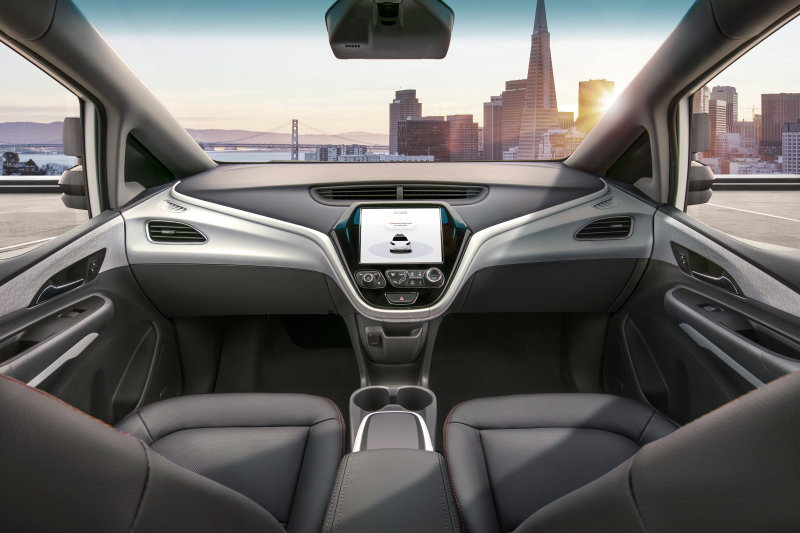GM files petition asking DOT permission to deploy self-driving Cruise AV in 2019; no steering wheel or pedals
 |
| No steering wheel coming |
General Motors has filed a Safety Petition with the US Department of Transportation (USDOT) for GM’s fourth-generation self-driving Cruise AV–No driver. No pedals. No steering wheel. Just seats and screens and doors that can close themselves. That's what riders will see when they get into one of General Motors' Cruise self-driving electric vehicles, scheduled to hit the road in 2019.
On Thursday, the automaker also stressed that the fully autonomous vehicle would emphasize safety — and went into great detail on the hows and whys, including redundant systems intended to replace a human driver.
On a conference call with reporters, GM President Dan Ammann said that the vehicle is the fourth generation of the vehicle to emerge from the carmaker's Cruise division. GM acquired what was then Cruise Automation, a Silicon Valley startup, in 2016.
"We're super excited to share this point in the journey," Ammann said.
The third generation, based on the Chevy Bolt, was showcased in San Francisco for the media late last year, so GM Cruise has been able to reveal four iterations in 18 months, Ammann said.
That's rapid progress and a testament to a critical early design and engineering decision: to pair Cruise's technology, optimized for complicated urban environments such as San Francisco, with GM's ability to develop and manufacture vehicles at a massive scale.
Asked to rank that process in terms of competitive advantage on a scale of one-to-10, Ammann said it was a 12.
Cruise CEO Kyle Vogt, also on the call, added that it's "very binary."
"Either you can do that, or you don’t have a business," he said.
GM estimated that it could currently roll out its fourth-generation autonomous vehicles in seven US states without creating any legal problems. Federal authorization would have to come from the National Highway Traffic Safety Administration (NHTSA), something Ammann said that GM has asked the government to allow. The carmaker has also published an extensive safety report to facilitate the process.
The carmaker intends to work with states that might have existing legal restrictions on self-driving vehicles to resolve any potential problems by 2019. GM used the example of a requirement to have a steering-wheel airbag. Because the new vehicle doesn't have a steering wheel, the company wants to able to use a passenger-side-type airbag to satisfy the rule.
In its safety report, GM returned to the integrated-manufacturing priority that it believes has enabled Cruise to produce its vehicles with safety at the forefront.
"By integrating our self-driving system into the vehicle from the beginning, and through close coordination between the hardware and software teams, we have evaluated potential failure modes for all systems, and addressed them throughout development to ensure a safe and reliable product," the report reads.
"This comprehensive, integrated approach to safety, combined with testing in one of the most complex environments in the world, allows us to safely take the next step — elimination of the steering wheel, pedals and other manual controls — from the vehicle."
Vogt, who joined GM when Cruise was bought, thinks this is big deal.
"What’s really special about this, when we look back 20 years from now, is that it will be a major milestone– to create production-ready vehicle with no manual controls," he said.
SUMMONED BY SMARTPHONES
When in operation, the vehicles will travel geo-fenced areas, summoned by smartphones.
"When we deploy our self-driving vehicles, customers will use a mobile app to request a ride, just like they use ride-sharing today," GM said in its safety report. "The only difference is that customers will control the experience — their customized climate control and radio station settings will be sent to the vehicle ahead of when they access their ride."
It might be weird when these vehicles first appear on the street, but over time, the company expected people to get used to them. And GM is prepare to build plenty of self-driving cars at its Orion Township plant in Michigan.
"It's the biggest assembly plant in the GM system," Ammann said. "We have fantastic capacity to build the vehicle."
The Cruise AV is equipped with five LiDARs, 16 cameras and 21 radars. These sensors and cameras all scan both long and short range, with a 360Ëš view around the vehicle. With its laser measurements, LiDAR provides precise feedback for both fixed and moving objects. Radar’s electromagnetic pulse measurements are complementary to LiDAR because they can detect solid objects that have low light reflectivity.

GM is using both LiDAR and rara inputs to measure the speed of moving objects, allowing quick determinations of speed.
The cameras measure the light intensity reflected off or emitted from objects, providing rich detail. GM combines camera and LiDAR data to classify and track objects. This helps, for example, in identifying pedestrians, determining vehicle types, and detecting road details such as lane lines and signage.
Complementary long-range sensors track high-speed objects such as oncoming vehicles; short-range sensors provide details about moving objects close to the vehicle.
A number of systems work together to deliver the self-driving capabilities based on the perceived data form the sensors:

Systems diversity and redundancy is key to the safety of the Cruise AV:

